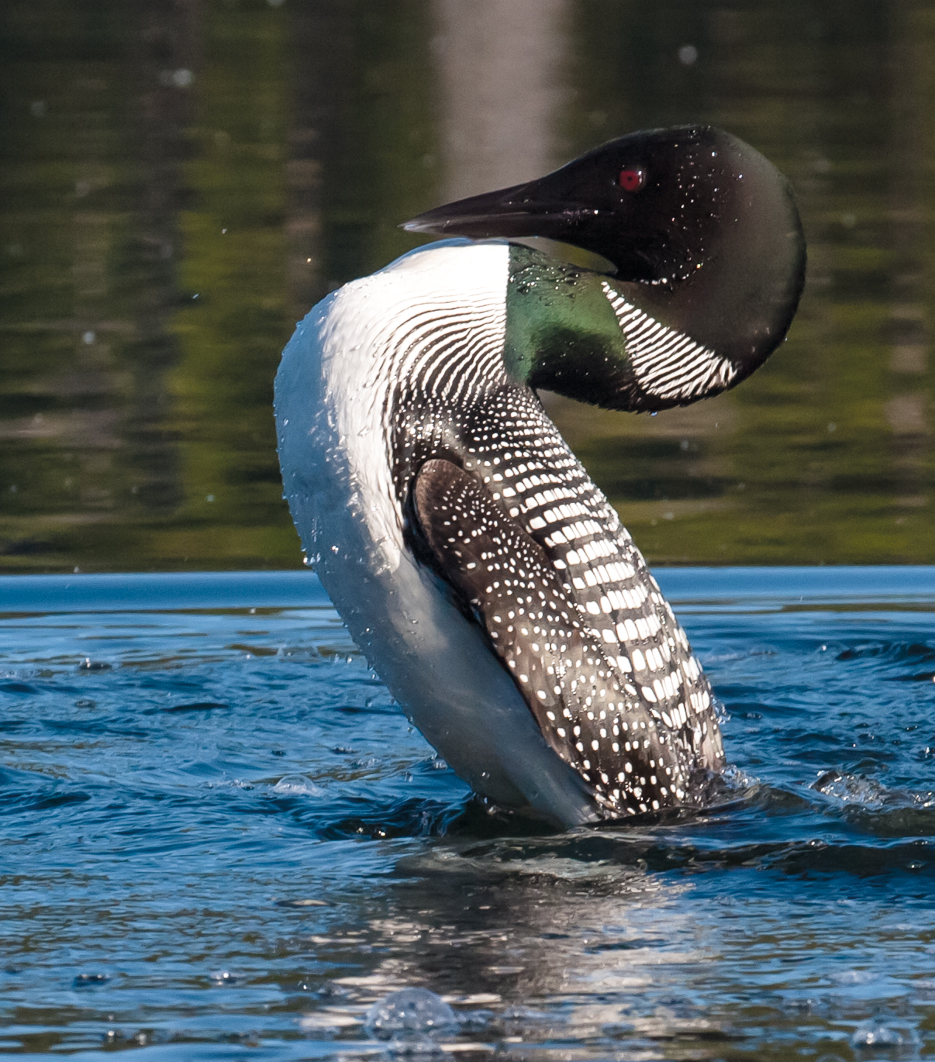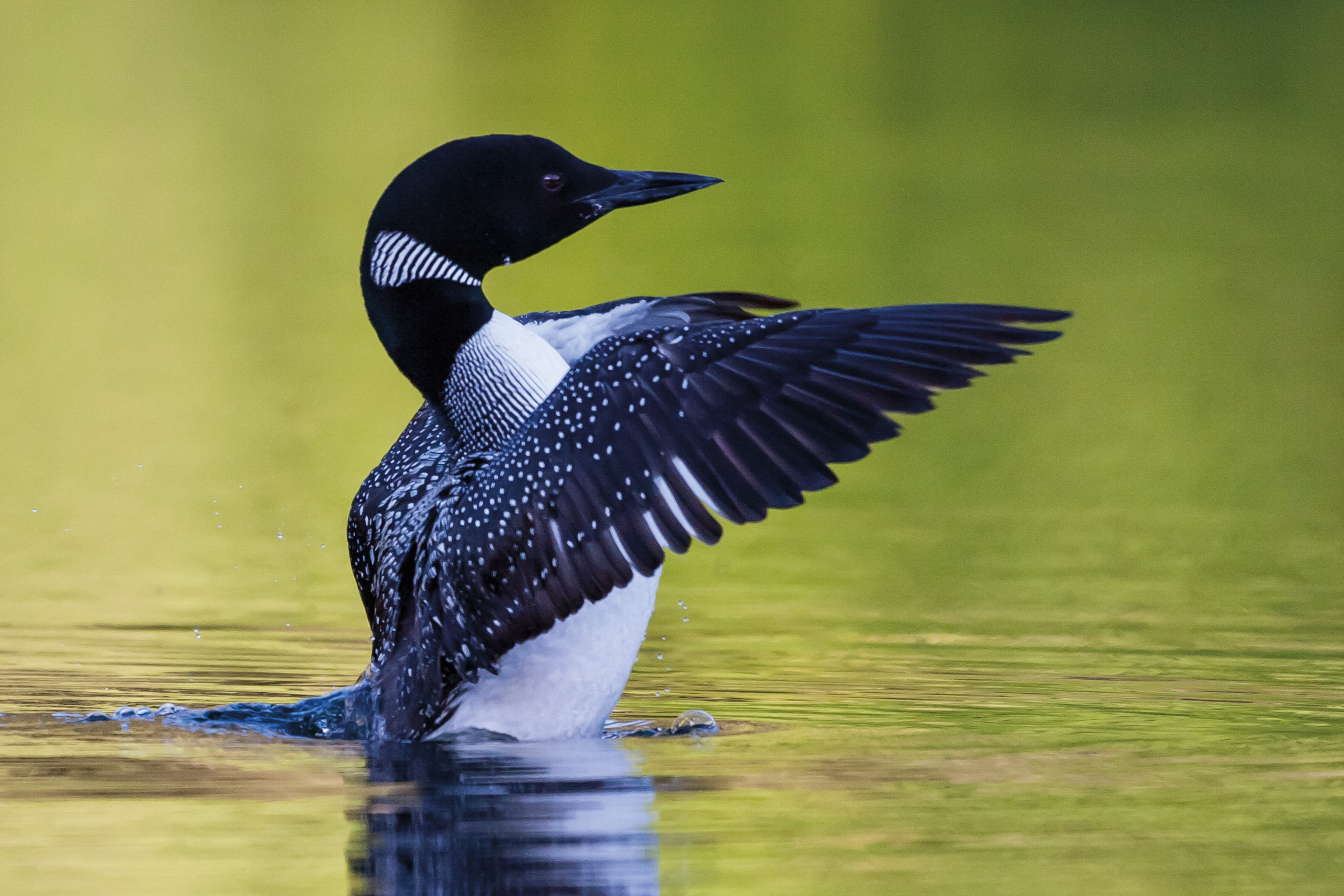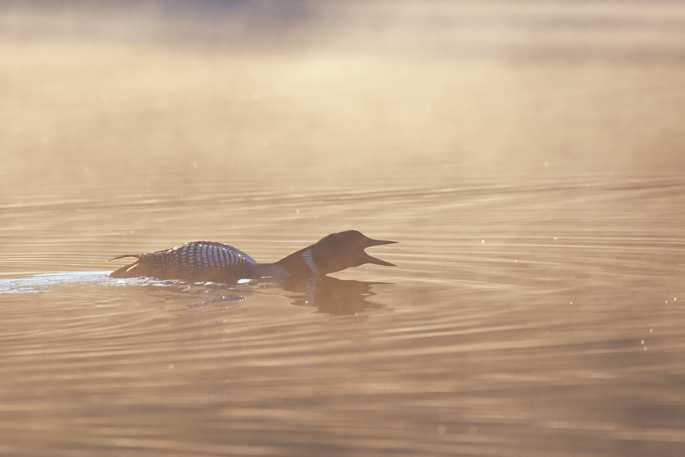
Biodiversity Research Institute’s Loon Program is dedicated to assessing current and emerging threats to loons, and to collaborating with the many agencies and organizations that work to conserve loon populations across the Northern Hemisphere. The Institute’s research and conservation projects contribute to understanding basic ecology and strive to unravel the impacts of ecological stressors and how they can be lessened.
At nearly dusk on an August evening in 1998, my research partner and I set out in a canoe to capture and color-band loons on a secluded lake on Mount Desert Island in Maine. We hoped the quiet of night and carefully chosen recordings of loon calls would draw the pair and young chick close. The sky shimmered white with northern lights, mirroring the low spiraling layers of mist that had formed over the water. In the deepest parts of the lake, the air felt cool, turning rich and earthy with stirred sediment as we poled through shallower areas. We moved slowly in the direction of the natural loon calls, noting the flights of bats overhead, their movements curving with the arc of our paddles in the water.
Silently hidden in the scene, we followed the night—across the pond and into darkened coves, sometimes chasing the sudden slap of water made from a dive in the shadow of our canoe. At dawn, we were forced to quit, the early light exposing both our intent and our position.
Although we did not succeed in capturing the loons that particular night, we left feeling rewarded. This is the gift of sharing space with these inspiring birds, and is a reminder of the importance not only of loons, but of the places in which they live. Sigurd Olsen, a naturalist and writer of the North Woods, once wrote of loons as a symbol of wildness, reminding us of our own connection to nature. We have found this to be very true.

The Allure of Loons
Loons have been charted through history in cultural myths and legends, and continue to richly characterize the woodland waters and landscape. Depicted here in selected photographs is the seasonal cycle of loons—from their twice-yearly migrations, to claiming territories and mates in the spring, through the hatches of summer and fledges of fall, and finally, to the solitude of winter. These images by wildlife photographers Ginger and Daniel Poleschook, our colleagues in loon research, offer a rare opportunity to witness the private moments of loons

The Common Loon—Distribution
The Common Loon (Gavia immer), one of five loon species that exist worldwide, is the only loon species that breeds in the contiguous United States. The closely related Yellow-billed Loon (G. adamsii) is a strictly tundra and coastal plain breeding species and is the rarest loon species (around 3,000 individuals in Alaska). Pacific (G. pacifica) and Arctic Loons (G. arctica) are smaller than the Common Loon. The Pacific Loon is mostly restricted to North America, while the Arctic Loon is primarily a breeding species found in Europe and Asia. Lastly, the Red-throated Loon (G. stellata) has the widest range of all loon species and is found across the Northern Hemisphere. An estimated 620,000 loons call North America their summer home, with their numbers growing in the fall to more than 725,000 with the addition of summer’s chicks. The core part of the loon’s breeding range is in Ontario and Quebec, with other large breeding centers in the Northwest Territories and British Columbia. The largest U.S. breeding populations, with more than 12,000 adults, each occur in both Alaska and Minnesota.

Spring Migration—Arrival on the Breeding Lakes
The lengthening days trigger Common Loons to start moving from their wintering areas on marine waters toward their breeding lakes, where they appear in full breeding plumage. While some individuals arrive in the southern periphery of their breeding range as early as mid to late March (typical in Washington, the lower Great Lakes, and southern New England), most loons will initiate migratory flights in early to midApril, continuing along either the Atlantic or Pacific coasts.
As loons finally reach their breeding lakes, experienced male loons arrive on territory first. Seasoned loons have already successfully held territories and raised young. Their early arrival gives them an advantage; they now have the time to feed and regain energy reserves after the long, taxing migration and before the need to reclaim a mate and defend a territory. The arrival of established males can precede similarly experienced females by several days, followed later by those less experienced, including first-time breeders sometimes four to six weeks later.
While loons carry a strong reputation for returning to the same lake each year, scientific studies of banded loons have shown that this is not always true. On average, eight out of ten adult loons return to territories held in previous years. Some adults return to the same lake, but move to new coves after losing their territory to a rival. Others may relocate to a neighboring lake after losing such a contest. Rarely do adult loons venture to lakes more than two to three miles from their former territories.
For loons, fidelity lies with their territory, not with their mate; this attachment to a site by both male and female drives regular pairing of the same individuals from year to year. It is rare, however, for the same pair to remain together for more than seven years

Lake Ecology
The primary goal of loon pairs during the spring season is to acquire and maintain a territory in optimal habitat for raising young. Ideal lake size varies. Some loons nest on lakes as small as 13 acres, but most loon pairs select waterbodies greater than 60 acres. When lakes exceed 200 acres in size, there may be enough room for two pairs. Much larger lakes may have 50 or more pairs of loons. Lakes and reservoirs with clear water and n abundance of small fish provide the best habitats because loons are visual predators primarily focused on fish. Other features such as irregular shoreline configurations, presence of isolated coves, and multiple nesting islands contribute to habitat quality.

Breeding Ecology
During the courtship period, the male selects a site where both adults work together to build their nest. Loons prefer to nest on the shoreline edge of small islands or quiet coves, favoring sedge hummocks or floating bog mats. They construct their nests with whatever materials are readily available such as grass, moss, twigs, and mud. Some loons fashion elaborate nest bowls with piles of vegetation, while others assemble coarse stick structures. Depending on the territory, loons may simply lay their eggs in shallow scrapes in sand or even on hard rock.
When the nest is ready, the female lays one to two eggs, each about five inches long, olive colored, and speckled for camouflage. The loon pair shares the rigors of a month-long incubation period; during the day, the partners exchange sitting duties every four to six hours. Females tend to sit for longer periods in the early days of incubation, especially at night when the males are often patrolling on the water, their distinctive yodels punctuating the night sky to warn other loons away.
At the end of incubation, chicks emerge from the shell within a day of each other (known as an asynchronous hatch). Sequential hatching gives the first chick a head start at successfully attracting parental attention and securing food. Newly hatched chicks are buoyant during their first few days and have difficulty maneuvering. Protection by the adults is essential for survival, and therefore loon families stay close, softly hooting to one another to maintain contact. In these early days, loon chicks seek rest and refuge from cold water and predators by riding on the backs of the adults. Adults catch small fish and insects, such as dragonfly larvae, and transfer prey from their bill tip to the chick. Until chicks molt completely out of their downy feathers, they tire easily and are susceptible to predators such as pike, bass, snapping turtles, and Bald Eagles. After six weeks of age, chicks display more advanced skills, including capturing prey underwater. By summer’s end, they can feed and fend for themselves, and have begun the first steps toward full flight.

Fall Migration—Return to the Ocean
By early fall, chicks are cloaked in smooth gray feathers instead of the downy brown of new chicks. The contoured feathering of young loons is more streamlined, further enhancing their ability to dive and catch fish.
Like their chicks, adult loons change appearance in the fall. The lustrous black and white feathering of the summer loon, also known as the breeding or alternate plumage, is replaced by the gray-brown of winter, or basic plumage. The timing of this process, referred to as molting, is likely dependent on changing hormones, individual age, and even environmental stressors. The first signs of molting appear as a silver-gray shadow at the base of a loon’s bill, and then progresses across the head and over the upper back. Flight feathers remain unaffected during this fall transition since they are necessary for the migration ahead. Loon pairs are territorial through the summer. As the leaves turn, chicks become more self-reliant, allowing the adults to relax their vigilance. They leave their young for periods of time to socialize with other adults on their lake or nearby lakes.
We know that one adult loon leaves the family first, usually followed by the second adult within a few weeks. The chicks are left to migrate by themselves. Some adult loons, especially those without young, leave their breeding lakes in late summer, but most begin their journey south in the latter part of September or October.
Conservation
We place value on the things we care for, and that compels us toward further study and action. Grassroots organizations dedicated to loon conservation have brought concerned citizens together with biologists to document and safeguard the natural cycles and places of loons. The importance of loons, however, is much older than science. For many of us, a starry night and a chorus of loons is nourishment. To care about loons is to fully know we are less without their companionship.
In the fall of 2020, BRI will host an International Loon/Diver Symposium in Portland, Maine. We invite loon researchers and conservationists, state and federal employees, wildlife rehabilitators, students, and loon enthusiasts from across the northern hemisphere to share knowledge and expertise.
To learn more, visit: www.briloon.org/ loons 2020

Involved in loon conservation since 1995, Kate Taylor is currently the wildlife outreach specialist for Biodiversity Research Institute’s Center for Waterbird Studies in Portland, Maine, US. Before joining BRI, she spent 12 years overseeing the scientific program for the Loon Preservation Committee in New Hampshire. She is a contributor to the U.S. Fish and Wildlife...
By Peter Hudson | Photos by Beatrice Bello, Grace Miller, Peter Hudson, Diveshmohanan, Hermis Haridas and Nisha Purushothaman
PT Aware 5 minutes read
ReadBy Kiran Ranga | Photos by Kiran Ranga
PT Explorers 7 minutes read
ReadBy Nisha Purushothaman | Photos by Nisha Purushothaman
PT Explorers 10 minutes read
ReadEmail: email@pawstrails.com